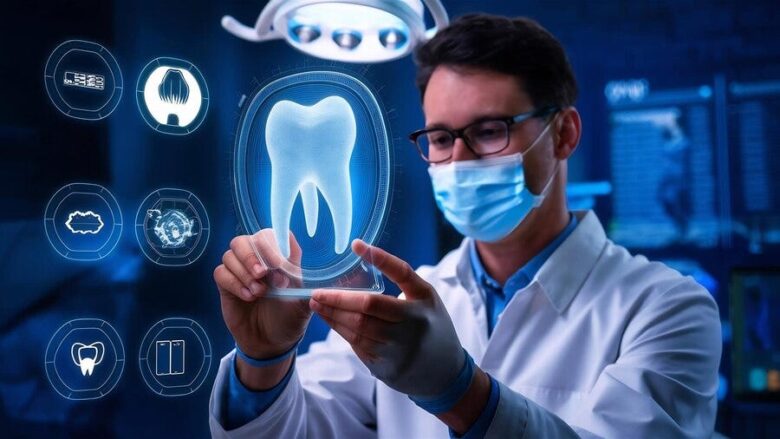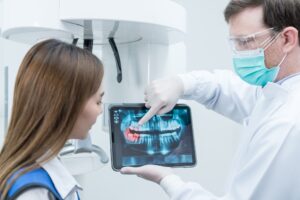Dentistry is no exception, with artificial intelligence (AI) rapidly becoming one of the most important developments in healthcare today. To improve accuracy, speed, and patient care, dentists are now using AI-based solutions in the diagnostic process. Faster than traditional technologies, these smart technologies can examine dental images, identify trends, and make recommendations. This allows dental professionals to make more informed choices, reduce human error, and create more personalized treatment plans. Artificial intelligence in dental diagnostics is not only changing the way dentists work but also improving patient outcomes and well-being.
Discover how AI is Impacting Image Analysis
The analysis of dental X-rays and other imaging techniques, such as cone beam computed tomography (CBCT) scans, is one of the key areas where AI is having a significant impact. Traditionally, it takes years of training and expertise for dentists to be able to read complex images correctly. Today, AI-powered systems can examine these images with astonishing accuracy and detect early signs of decay, bone loss, cysts, cancer, and other oral health issues. Thanks to deep learning algorithms trained on hundreds of images, these systems can detect small abnormalities that are invisible to the human eye.
Improve Early Detection of Dental Problems
Prevent serious dental problems and reduce the need for extensive treatment through early diagnosis. AI is adept at identifying problems at an early stage, often even before symptoms become visible. By using small changes in tissue or bone structure, AI can detect the development of cavities or gum disease at a very early stage. Dentists who identify problems early can perform less invasive treatments and thus increase the chance that your natural teeth will be preserved. This proactive strategy not only improves the oral health of patients but also reduces the overall cost and complexity of dental care.
Reduce Dental Diagnostic Errors
In dentistry, diagnostic errors can lead to patient stress, incorrect treatments, and delays in care. AI’s consistent, data-driven assessments can help reduce these errors. Unlike humans, AI systems do not get tired, distracted, or biased. They can therefore provide consistent assessments over and over again. Combined with human knowledge, AI can act as a second pair of eyes, double-checking the diagnosis and ensuring that nothing has been missed. This combination of human judgment and machine accuracy sets a new standard for diagnostic accuracy in dental practices.
Customized Dental Treatment Plans
AI can also develop customized treatment plans by examining large amounts of patient data. Using artificial intelligence (AI), dentists can determine which treatment plan will be most successful for each patient, using medical history, genetic data, lifestyle choices, and imaging results. This customized strategy can lead to better outcomes and happier patients. Dentists gain access to information that supports their clinical judgment, while patients benefit from treatment that is tailored to their individual needs. As AI systems develop, this personalization will become more sophisticated and powerful.
Improve Clinic Workflow and Efficiency
AI can not only facilitate diagnosis but also streamline the overall workflow in the dental practice. Automated AI solutions can process patient data, schedule appointments, and even help with insurance and billing. In diagnostics, AI can quickly review images and generate reports, saving dentists valuable time. With increased efficiency, dentists can focus more on patient care and less on administrative tasks. Clinics can treat more patients, reduce wait times, and provide better care without sacrificing accuracy or attention to detail.
AI-Assisted Tele- Teledentistry and Remote Diagnosis
The growth of telemedicine is making AI a major catalyst for remote dental diagnostics. Patients can now upload videos or photos of their dental problems to the clinic; an artificial intelligence (AI) algorithm evaluates the images and provides an initial assessment. This feature is especially useful for people living in rural or poor areas who do not have easy access to a dental office. AI can help bridge the gap by offering virtual consultations and ensuring that patients receive a timely consultation. In addition, AI remote diagnostics can help reduce unnecessary visits to the doctor and promote more efficient use of medical resources.
Education and Training of Dental Professionals
Artificial intelligence is also changing the way dentists are trained. Modern dental schools are integrating AI-based technologies into their curricula, allowing students to practice diagnosing with the help of smart software. By simulating realistic situations and providing rapid feedback, these tools can help future dentists gain confidence and strengthen their skills. AI can identify errors, suggest changes, and advise on best practices. Therefore, AI is not only a diagnostic tool but also a learning tool to improve the knowledge and skills of dentists.
Conclusion
Artificial intelligence is changing dental diagnostics by improving accuracy, promoting early detection, and streamlining processes. The ability to view images, process data, and personalize treatments is ushering in a new era for dentistry, making patient care more efficient, professional, and successful. As AI tools become more advanced and widespread, they will continue to help dentists provide high-quality treatments. AI in dental diagnostics shows a lot of promise and has the potential to influence oral health for years to come, despite current challenges. Careful and responsible use of these technologies will help patients and doctors achieve better results.
FAQs
1. How can artificial intelligence be used in dental diagnosis?
Artificial intelligence in dental diagnosis is the application of AI technology to examine dental data and images, allowing dentists to identify oral health problems more accurately and quickly.
2. Can artificial intelligence take over the role of a dentist?
No, AI is not designed to replace dentists. It is a useful tool that can help professionals make better decisions, reduce errors, and provide better patient care.
3. Can AI be used safely in dentistry?
When used correctly, AI is safe and can improve diagnostic accuracy. However, human supervision is imperative to ensure the best outcome.
4. How can AI detect dental problems early?
AI can intervene earlier and enable more immediate treatment by examining dental images for subtle signs of decay or disease that are invisible to the human eye.
5. Will AI make dental treatments more expensive?
While there may be an initial cost associated with using AI technology, these systems can often lead to more effective treatments and reduce long-term treatment costs by identifying problems early.




